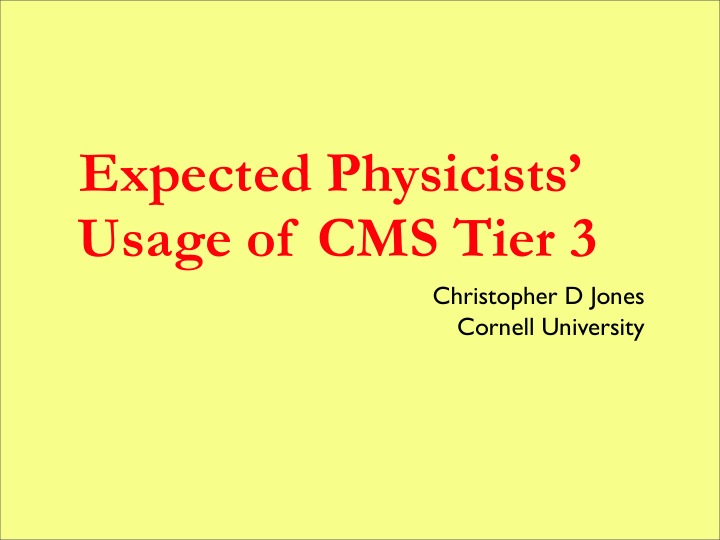



Expected Physicists’ Usage of CMS Tier 3 Christopher D Jones Cornell University
Overview Physicist’s Activities Tier Strengths Activities at Tier 3s Coding Testing Small Batch Jobs Grid Submissions Interactive Usage OSG Workshop 2007/ 03/ 07
Physicists’ Activities Code Development Done for analysis, reconstruction, calibration, simulation,etc. Easiest if have full CMS software release available Monte Carlo Studies Test code using small samples Generate small samples to test for correct generation Generate large samples Read and skim large samples Iteratively examine skimmed samples Possibly re-skim to get additional information Data Analysis Test code using small samples Read and skim large samples Iteratively examine skimmed samples Possibly re-skim to get additional information Systematic Studies Iteratively examine skimmed samples Possibly re-skim to get additional information OSG Workshop 2007/ 03/ 07
Tier Strengths T0 CERN First to process the data T1 USA = FNAL Lots of CPU power and storage Partial copy of the ‘raw’ detector data Full copy of the ‘analysis level’ (AOD) data Archive of T2 produced MC T2 San Diego, Caltech, Nebraska, Wisconsin, Purdue, MIT, University of Florida In total will have lots of CPU power Individually will hold ‘analysis level’ (AOD) data of interest to particular groups Generate lots of MC T3 Computing resources dedicated to specific group Quick response to physicist’s activities OSG Workshop 2007/ 03/ 07
Coding All coding tasks require a CMSSW software release At the moment, the ability to read a particular file can depend on the software release used to create that file Physicists usually stay with one software release for a long time several releases will probably have to be available at a site to accommodate all physicists A new major release is made about every month This rate will decrease but probably not until a year after initial data taking Will want to have the code installed locally It is possible to remotely build over afs but it is ‘beyond painful’ Useful resources One release takes about 1.5GB of disk space + ~1 GB for externals shared by releases A fast multi-CPU compilation machine with the releases on its local disk compilation time is usually dominated by I/O OSG Workshop 2007/ 03/ 07
Running Locally For some cases, running a job at T3 may give faster results Testing or debugging Local copy of skimmed data Interactive Requires full installation of CMSSW software release Useful to have dedicated machine(s) for short jobs typically no longer than 5 minutes need good network connectivity to software release disk cmsRun dynamically loads shared libraries and load time is dominate startup cost of jobs PhEDEx can be used to retrieve data from T1/T2 Local batch queue useful for longer jobs Condor is the queue of choice for the US grid NOTE: if data is available at T2 and jobs take longer than an hour, better to submit jobs to the grid. OSG Workshop 2007/ 03/ 07
Grid Submission MC and data will be on T1 and T2 Physics groups will request large MC sample generation and prepare standard data skims All of these will be in the CMSSW EDM ROOT format used by cmsRun Physicist’s find data using the Database Bookeeping System (DBS) Physicist just use a web browser to lookup the data Physicists will want to process these samples CRAB is CMS physicists’ grid submission tool Need to install CRAB (separate from CMSSW) and a grid user interface (UI) http://uscms.org/SoftwareComputing/UserComputing/Tutorials/Crab.html Once job is finished, physicists will want to transfer resulting skims back to T3 Present Large files (>100MB) need to be written to a grid ‘storage element’ Physicists need write permission to a T1 or T2 storage system Use ‘srmcp’ to copy data from the storage system to T3 Future Physicist’s jobs will write into CMS’ storage space (i.e. namespace) Data will be visible to DBS Use PhedEx to transfer data back to T3 OSG Workshop 2007/ 03/ 07
Interactive Files used by CMSSW are intended for direct use in ROOT Bare ROOT Can do simple ‘TBrowser’ plots in ROOT without having libraries FWLite Automatically load libraries with proper object ‘dictionaries’ Give full ROOT macro (or python) access to data Also works for compiled code (dictionaries set how to read data from file) TFWLiteSelector TSelector is ROOT’s ‘modular’ processing system TFWLiteSelector lets you get data from a edm::Event just like in cmsRun Amount of data needed by an analysis will probably exceed the ability to interactively plot quantities using only one machine Groups in CMS are exploring use of PROOF PROOF is ROOT’s distributed computing environment Allows one Root application to use multiple machines in a local cluster to process physicist’s data in parallel Only works with TSelector CMS Week on December 2006 had a session on progress http://indico.cern.ch/conferenceDisplay.py?confId=8814#18 Getting this to work is a priority of the Physics Tools group I’d take a ‘wait till problems worked out’ approach OSG Workshop 2007/ 03/ 07
Conclusions T3s are likely to be the main ‘gateway’ to CMS for most physicists T3s ability to quickly respond to physicists activities is their greatest strength Quick compilation/debugging of code Ability to test by running very short jobs Local batch jobs for processing small amounts of data quickly Support for interactive data exploration OSG Workshop 2007/ 03/ 07
Recommend
More recommend